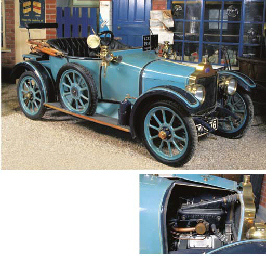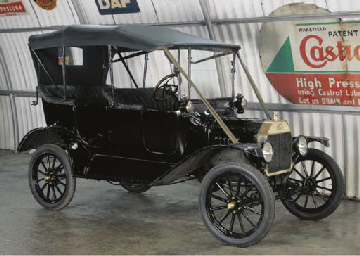1904 BRITISH DURYEA THREE CYLINDER 12 HP SURREY Registration No. Tba Engine No. 61 Grey and red with red interior Engine: three-cylinder 4½" x 4½" bore & stroke, 3,520cc, with pushrod & rocker operated in-head inlet and exhaust valves, water-cooling, splash lubrication, generator and coil ignition. Horizontal-mounted under floor, the cylinder heads facing to the rear; Gearbox: Two-speed epicyclic gears, enclosed chain drive; Suspension: front, semi-cantilever cum scroll springs, rear, semi-elliptic leaf springs; Brakes: transmission brakes. Wooden artillery wheels with solid rubber tyres. Driving control by multi-function tiller serving steering, gear-change, brake, and engine regulation. Since the Duryea brothers Charles and Frank spent their lives openly feuding with one another about which of them invented the automobile and who made what, when, and where, and books have been written on this subject, suffice it to say that the first series-produced American cars made in 1896-7 carried the name Duryea. Around 1900 Charles Duryea designed and built cars of the pattern of this vehicle, in Reading, Pennsylvania, and in 1902 Henry Sturmey, former Editor of The Autocar , obtained a license to produce the cars in England. Ostensibly these were made in Coventry where he was based, although pre-1904 examples were almost certainly imported from America and construction of British Duryeas was actually carried out by the respected and in its day well known engineering firm of Willans & Robinson of Rugby. That the cars were unorthodox should be evident from the above technical synopsis. However, even by 1904 there was a tide flowing in the affairs of motorcar design against which characters even as resolute as Charles Duryea or Frederick Lanchester found it impossible to swim. Rightly or wrongly the car-buying public demanded a front-mounted engine, and although there was less concern about the details of transmission systems, normal driving controls - particularly wheel steering - were favoured, and very importantly a motorcar was required conform to the perception of what a motorcar should look like. So, regardless of the fact that Duryea, like Lanchester, proclaimed the virtues and logic of his designs, by and large the public were unpersuaded and bought conventional cars. The engine appears to have been a sound design with a 120 degree crankshaft, at a time when most other makers of 3-cylinder engines used a 180 degree pattern, whilst the pushrod-operated overhead valves (well they would have been overhead if the engine had been mounted vertically) were quite possibly the first application of this now long-familiar system. The fact that this engine was mounted in the centre of the car need not have been a serious negative factor, after all many American runabouts had their engines just so, but the chassis layout was unconventional, as were the controls, and so was the overall appearance of the vehicle. Sturmey promoted the cars to a degree, achieving publication of a letter in The Autocar of July 2nd 1904 describing a satisfactory Coventry-Land's End round-trip by two Duryeas, a 15hp and a 12hp, whilst a three-wheeled 10hp version won the 'under £200' class at the 1904 Bexhill Speed Trials. In January 1905 an owner informed The Autocar that: 'My experience dates from July, and I may say that the driving is quite different from any other car that I have been on. There is less to do and the running is smoother, easier and more 'automatic' … I find I can take practically everything on the top speed and am generally well pleased with the car.' In October 1905 The Automotor Journal published a photograph of a new British Duryea owned by a Dr Mackay of Knaresborough, the third example that he had bought. But although some were obviously converted to the Duryea way of doing things, they were in reality few and far between and production faded away in 1906. In 1947 this British Duryea belonged jointly to VSCC stalwart Kenneth Neve and
1904 BRITISH DURYEA THREE CYLINDER 12 HP SURREY Registration No. Tba Engine No. 61 Grey and red with red interior Engine: three-cylinder 4½" x 4½" bore & stroke, 3,520cc, with pushrod & rocker operated in-head inlet and exhaust valves, water-cooling, splash lubrication, generator and coil ignition. Horizontal-mounted under floor, the cylinder heads facing to the rear; Gearbox: Two-speed epicyclic gears, enclosed chain drive; Suspension: front, semi-cantilever cum scroll springs, rear, semi-elliptic leaf springs; Brakes: transmission brakes. Wooden artillery wheels with solid rubber tyres. Driving control by multi-function tiller serving steering, gear-change, brake, and engine regulation. Since the Duryea brothers Charles and Frank spent their lives openly feuding with one another about which of them invented the automobile and who made what, when, and where, and books have been written on this subject, suffice it to say that the first series-produced American cars made in 1896-7 carried the name Duryea. Around 1900 Charles Duryea designed and built cars of the pattern of this vehicle, in Reading, Pennsylvania, and in 1902 Henry Sturmey, former Editor of The Autocar , obtained a license to produce the cars in England. Ostensibly these were made in Coventry where he was based, although pre-1904 examples were almost certainly imported from America and construction of British Duryeas was actually carried out by the respected and in its day well known engineering firm of Willans & Robinson of Rugby. That the cars were unorthodox should be evident from the above technical synopsis. However, even by 1904 there was a tide flowing in the affairs of motorcar design against which characters even as resolute as Charles Duryea or Frederick Lanchester found it impossible to swim. Rightly or wrongly the car-buying public demanded a front-mounted engine, and although there was less concern about the details of transmission systems, normal driving controls - particularly wheel steering - were favoured, and very importantly a motorcar was required conform to the perception of what a motorcar should look like. So, regardless of the fact that Duryea, like Lanchester, proclaimed the virtues and logic of his designs, by and large the public were unpersuaded and bought conventional cars. The engine appears to have been a sound design with a 120 degree crankshaft, at a time when most other makers of 3-cylinder engines used a 180 degree pattern, whilst the pushrod-operated overhead valves (well they would have been overhead if the engine had been mounted vertically) were quite possibly the first application of this now long-familiar system. The fact that this engine was mounted in the centre of the car need not have been a serious negative factor, after all many American runabouts had their engines just so, but the chassis layout was unconventional, as were the controls, and so was the overall appearance of the vehicle. Sturmey promoted the cars to a degree, achieving publication of a letter in The Autocar of July 2nd 1904 describing a satisfactory Coventry-Land's End round-trip by two Duryeas, a 15hp and a 12hp, whilst a three-wheeled 10hp version won the 'under £200' class at the 1904 Bexhill Speed Trials. In January 1905 an owner informed The Autocar that: 'My experience dates from July, and I may say that the driving is quite different from any other car that I have been on. There is less to do and the running is smoother, easier and more 'automatic' … I find I can take practically everything on the top speed and am generally well pleased with the car.' In October 1905 The Automotor Journal published a photograph of a new British Duryea owned by a Dr Mackay of Knaresborough, the third example that he had bought. But although some were obviously converted to the Duryea way of doing things, they were in reality few and far between and production faded away in 1906. In 1947 this British Duryea belonged jointly to VSCC stalwart Kenneth Neve and















Try LotSearch and its premium features for 7 days - without any costs!
Be notified automatically about new items in upcoming auctions.
Create an alert